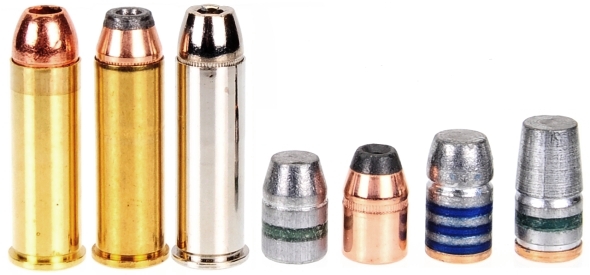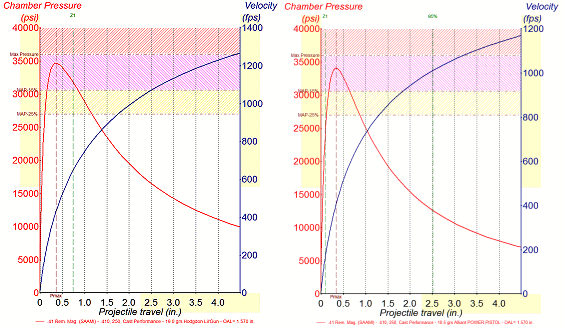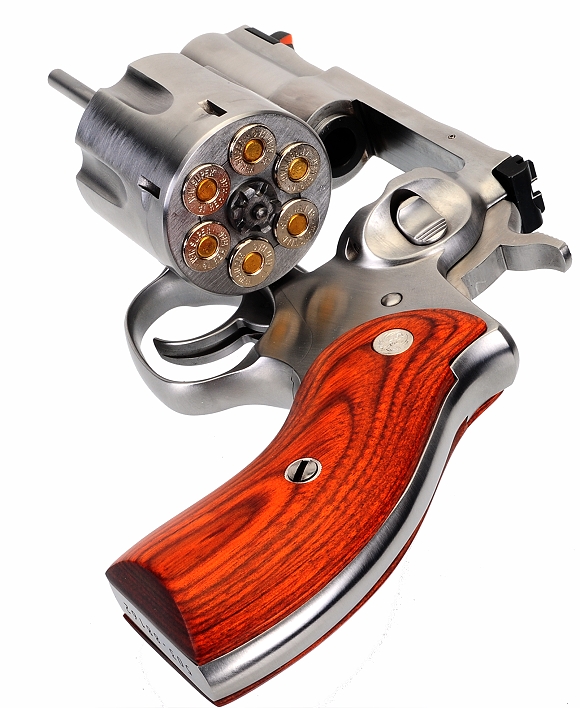
The 2 3/4″ barrel 41 Mag Ruger Redhawk is compact and convenient to carry, but short barrel length is a consideration when selecting ammunition and components. Will bullets expand and deliver the desired results at short barrel velocity, or if hole punching a .41 caliber wound channel is acceptable?
A place to begin…
Some folks like to point out that ammunition for the .41 Remington Magnum is limited. So I will point out that there are approximately twenty four types of ammunition, the combined product of eight manufacturers, and that most of it is available through online suppliers. In fact, there are only nine of the generally produced sixty three commercially loaded handgun cartridges that offer more choices and then there are the components for handloading that extends choices available.
The 41 Remington came around as an answer for law enforcement’s need for something a bit more powerful than the 357 Magnum, but a bit easier to handle than the 44 Magnum. Unfortunately, 1964 was a bad time to introduce a powerhouse revolver round, because, about fifteen minutes later, every law enforcement agency not under the jurisdiction of Sheriff Buford T. Justice changed over to autoloaders. The proof of this migration is that only four of the twenty four available factory loads are intended for self defense. The remaining twenty feature pictures of deer and black bear on their respective boxes and are loaded with bullet with very heavy jackets or are hard cast.

For our purposes, the above were selected as three factory loads and four component bullets for handloading: Barnes Vor-TX 180 grain, Federal Power Shok 210 Grain, and Winchester Platinum Tip 240 grain… all are primarily hunting rounds with tough bullet meant to deeply penetrate. Bullets: Hunter’s Supply 200 grain, Nosler 210 grain, Cast Performance 250 grain, was True Shot 265 grain… all hard cast and primarily bullets intended for hunting. I do wish component companies would stop resorting to misspelling for trademarks. We know it but the rest of the world is convinced firearm enthusiasts can’t spell.
In handloading, there is no such thing as a nominal dimension…
Dimensional differences in bullet lots lead to differences in seating depth. Seating depth differences alter the net powder capacity of an assembled cartridge, which in turn means pressure variations even with identical powder charges. Subsequently… consequently, I measure bullets for overall length and seating depth.
|
Manufacturer |
Bullet Type |
Bullet Weight Grains |
Overall Length “ |
Crimp Groove Depth “ |
| Hunters Supply | FP | 200 | 0.632 | 0.370 |
| Nosler | JHP | 210 | 0.688 | 0.370 |
| Cast Performance | WFNGC | 250 | 0.766 | 0.470 |
| True Shot | WFNGC | 265 | 0.845 | 0.410 |
 |
Warning: Bullet selections are specific, and loads are not valid with substitutions of different bullets of the same weight. Variations in bullet length will alter net case capacity, pressure and velocity. Primer selection is specific and primer types are not interchangeable. These are maximum loads in my firearms and may easily be excessive in others. All loads should be reduced by 5%, and developed following safe handloading practices as represented in established reloading manuals produced by component manufacturers. Presentation of these loads does not constitute a solicitation for their use, nor a recommendation.
|
||||||||||||||||||||||||||||||||||||||||||||||||||||||||||||||||||||||||||||||||||||||||||||||||||||||||||||||||||||||||||||||||||||||||||||||||||||||
|
|||||||||||||||||||||||||||||||||||||||||||||||||||||||||||||||||||||||||||||||||||||||||||||||||||||||||||||||||||||||||||||||||||||||||||||||||||||||
The slow – fast powder – barrel length paradox…
Page three of the Gun Forums Guide to the Galaxy proclaims, “Handloads for short barrel firearms must use faster burning powder to achieve maximum velocity”. Yet you will notice on the table slow handgun powder for full power loads and Cheerios looking bulky Trail Boss only for low velocity loads. I did not list load data for fast powder types tried because all of it delivered lower velocity at maximum pressures: CFE Pistol, AutoComp, Titegroup, Power Pistol, and Unique were all tried.
How can that be?…!!. Slow powder remains unburned and ends up peppering the ground 20 feet away from the muzzle where fast burning powder is efficient and mostly burns up in the barrel. Fortunately, “Efficiency” is no more a goal for a performance cartridge than is gas mileage a consideration in a 1/4 mile drag race. In both cases the objective is horsepower and accuracy in intended destination.
Yes, it is true that only approximately 75% of H110 loads burns within the bore of this short barrel revolver, while nearly 100% of the faster powder is consumed, but what each achieves before a bullet leaves a short barrel is quite different.

The curve is much fatter for the H110 slow powder on the left, more of a spike for the Power Pistol pressure curve on the right which means greater average pressure for the H110. Looking up from the 2.75″ point on the bottom legend, barrel exit velocity is significantly greater for the H110 load than the Power Pistol load and muzzle pressure is significantly greater which means greater force is applied to the base of the bullet over the full length of the barrel with H110 than with Power Pistol. Frugal handloaders may mourn the waste of 25% of the H110 powder charge, but performance seekers will applaud what the 75% was able to achieve.
There is more coming on the issue of handloads, factory ammo and short and longer length barrels in the next installment. I just need to shoot a few hundred rounds to validate some results and to be able to collect more data points. So when we shift to a longer barrel version of the Redhawk, we’ll carry forward the short barrel results as well.
Short barrel Redhawk personality, accuracy…
The 41 Mag Redhawk is not modest in performance or behavior. A cast bullet weight of 265 grains at 1200+ fps is a penetrating round and more than enough for deer, hogs and black bear. Winchester Platinum Tip jacketed hollow points does not penetrate as much as cast, but it makes a huge wound channel while holding onto bullet weight and penetrating vital organs in medium size game. Could the 41 Rem Mag drop something larger in a tough situation? I am sure it can. Recoil is… sassy. It is less than a 44 Mag, but it would not be confused with a 357 Mag. The 41 Mag also has quite a bark.
The round butt and short barrel are features that facilitate concealment or ease open carry. The same features do represent a compromise in comparison to a 4″ or longer barrel revolver. This Ruger Redhawk would be high on my list for trail carry or a side arm while hunting firearm or something to take along on a wilderness fishing trip. It would not be first as a primary hunting firearm where maximum velocity and long sight radius provide a clear advantage.

At 50′ I could put three shots into less than a 3.5″ circle… with my glasses on and from a rest, but not a Ransom Rest. Could another shooter do better? Sure, that is a real possibility, but at this level of recoil and report, and this short of a sight radius, the Ruger was impressive and groups that size could be shot with any of the ammo noted. I think the smallest group size shot was just under 2″ at the same distance and that was with Winchester Platinum Tip.
I showed the Ruger around a bit; folks stopping in at the shop or house. People liked the look and feel, as do I. It is built like a tank, with lots of quality fit and finish and lots of real power. It is a revolver that would be difficult not to like. The questions answered within this part of the project gave rise to more questions. So we will be back with a longer barrel, more test and hopefully some useful results.

Ruger’s Redhawk 41 Rem Mag Part I
Ruger’s Redhawk 41 Rem Mag Part II
Ruger’s Redhawk 41 Rem Mag Part III

Email Notification